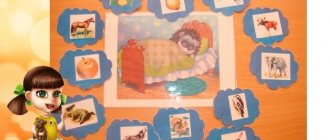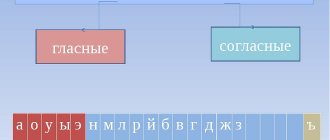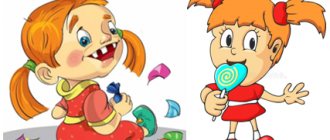Automation of the sound [P] in words with consonant clusters
Game “Name the Object” Constellation of consonants -TR-
Spin the wheel. What happened? Don't forget to pronounce the [R] sound correctly.
Game "Anagram" Constellation of consonants -DR-
Make a word from the letters. Read what happened. Don't forget to pronounce the [R] sound correctly.
Game "Quiz" Consonant cluster -DR-
Guess what this is from the fragments? Read all the options. Choose the right one. Don't forget to pronounce the [R] sound correctly.
Game “How many syllables” Constellation of consonants -DR-
What is shown in the picture? How many syllables are there in this word? Choose the right one. Don't forget to pronounce the [R] sound correctly.
Game "Find the word"
Find words among the scattered letters in the square. They can be horizontal and vertical. Hold down the left mouse button and drag across the word. Watch the pronunciation of the sound [R].
Automation of the sound [P] in words. Place of the sound [P] at the beginning, middle and end of a word
Game "Find it"
Find pictures that have the sound [P] in their names. Name them. Sign these pictures by clicking on the pins.
Game "Find and identify"
Name the toys whose names contain the sound [P]. Determine the place of the sound in the word (at the beginning, middle, end). To do this, click on the pins and choose the appropriate scheme.
Game "Help the robot Vini"
Together with the robot Vini, collect all the words with the sound [R]. Control the robot with arrows - move forward, move backward, and use space to jump.
Planet Vini
Game "Fourth wheel"
Name the objects, clearly pronouncing the sound [P]. Find the extra picture. Hint: extra picture without sound [P].
Fourth wheel
Game "Find the picture"
Game "Airplane"
When flying a plane, take pictures that have the sound [R] in their names. Name what you take.
Article:
Preschool age is a period of active development of cognitive activity.
At this time, the formation of the first forms of abstraction, generalization and simple inferences takes place, the transition from practical to logical thinking, the development of arbitrariness of perception, attention, memory, and imagination. The use of educational games in the pedagogical process makes it possible to restructure educational activities: move from habitual activities with children to cognitive play activities organized by adults, and at later stages - independent ones. Educational games technology developed by V. Voskobovich , important and interesting for children, varied in content, very dynamic. They include children’s favorite manipulations with gaming material, which is able to satisfy the child in motor activity, movement, helps children show speech activity in a relaxed atmosphere, and monitors the correct execution of actions. The principles underlying these games - interest - knowledge - creativity - become as effective as possible. Considering the characteristics of higher mental activity of the category of children under consideration, all of the above acquires the greatest significance. The versatility, diversity and age-appropriateness of V. Voskobovich's educational games allows them to be used to solve this problem - the correction and formation of the speech and intellectual abilities of preschool children with speech and language development disorders.
The gaming technology of Vyacheslav Vadimovich Voskobovich “ Fairytale labyrinths of games ” meets the requirements of the Federal State Educational Standard. It reveals each of the five presented areas of child development. The tasks set by the Federal State Educational Standard for each area of development, and the tasks solved by gaming technology V. Voskobovich , largely coincide.
Application of gaming technology B. Voskobovich can be adapted taking into account the characteristics of the mental and speech development of children with ODD.
Vyacheslav Vadimovich Voskobovich is an inventor who came up with more than 50 aids for the development of a child’s mental and creative abilities. During perestroika, looking around the shops for some educational toys for his two children and not finding anything suitable, he decided to invent and make a game himself. He beat and pounded everything by hand. He didn’t copy someone else’s stuff, and that’s why his new games aroused such interest. first developments were constructive in nature - it was a search for some kind of zest. Realizing that tasks and exercises are not as interesting for children as games, I approached the matter creatively and combined my ideas with game moments.
“ Fairytale labyrinth games ” are a form of interaction between an adult and children through the implementation of a certain plot (a game plus a fairy tale ). At the same time, educational tasks are included in the content of the game . A system of tasks, exercises, and questions is organically woven into the plots of methodological fairy tales The child listens to a fairy tale and completes tasks as the story progresses.
Constant and gradual complication of games (“in a spiral” from simple to complex). As a result of this approach, speech and non-speech mental processes develop: attention, memory, imagination, thinking, fine motor skills. This approach makes it possible to support children’s activities in the zone of optimal difficulty and to achieve one or another “objective” result in any game.
The principle of sensitivity. The authors “ Fairy Tale Mazes Game technology are not supporters of early accelerated development of children. All material is sensitive, that is, most favorable for the perception of preschool children, taking into account their psychological characteristics.
Formation of early creative development of preschool children. The game creates conditions for creativity and stimulates the development of the child’s creative abilities. The teacher, using the child’s natural need for play, gradually involves him in more complex forms of play activity.
All of the above principles are harmoniously combined with the principles of teaching and raising children with severe speech impairments (SSD).
1992 - first games of V. V. Voskobovich : “Geokont” “Game square”
“Folding boxes” “Color clock”, “Transparent square” “Transparent number” “Domino” “Planet of multiplication” “Miracle puzzles” “Math baskets” The first methodological fairy tales of the city . – more than 50 titles of games Games V. V. Voskobovich
Relevance Chinese wisdom says: “Tell me and I will forget, show me and I will remember, let me try and I will understand.”
GOAL: correction of speech disorders and development of accompanying non-speech processes through play , in a relaxed gaming environment. OBJECTIVES: 1. Develop mental processes of attention, memory, verbal-logical and creative thinking, imagination. 2. Develop cognitive activity skills. 3. Update, enrich children’s vocabulary, develop communication skills. 4. Instill interest in games with sound and words. 5. Form a positive emotional attitude towards the perception of educational material. 6. Develop fine motor skills of the hand. 7. Develop skills of basic self-control and self-regulation, coordinate your actions with the rules of the game , with the actions of peers and the teacher. PURPOSE AND OBJECTIVES OF TECHNOLOGY
His method is based on play. The game arouses the child's interest; The game is always educational; The game does not have strict rules and conditions; The principle of V.V. Voskobovich’s : interest - cognition - creativity.
“Purple Forest” “ Fairytale labyrinths of the game ” Purple Forest is a kind of virtual, non-existent world. The Purple Forest is a sensorimotor zone in which the child actively acts with educational games in the horizontal plane or attaches it to a vertical wall, realizing his creative ideas. Work using the “ Fairytale Mazes Games ” technology can be started at any age of preschool childhood. To implement the principle of gradual complication, children first need to master material intended for younger children.
MENTAL PROCESSES SPEECH FINE MOTOR SKILLS CREATIVE POTENTIAL PERSONAL QUALITIES
Educational games V. V. Voskobovich allow : Implement a differentiated approach. Allows you to diversify the ways of presenting game material. Children get tired less and remain productive
Games V. V. Voskobovich (in correctional speech therapy work ) develops motor skills of the hand and fingers, sensory abilities (mastering color, shape, size, mental processes (designing according to a verbal model, constructing symmetrical and asymmetrical figures, creativity
“Cord – ENTERTAINER” Orientation in space Improving intelligence Preparing for learning to read Mathematical development
Tactile and optical analysis of letters Corrective practice Preparation for learning to read and write Improving intelligence Development of fine motor skills and coordination of finger movements “LETTERS Designer”
“Cord - LITERATURE” Familiarization with letters and memorizing them Reading words invented and written by adults Independent writing of words Development of fine motor skills Snowman Apple tree Chamomile Sailboat
READ-KA on marbles Formation of interest in reading Distinguishing between voiced and voiceless consonants Sound analysis of words Dividing words into syllables, syllabic reading Construction and reading of words Expanding vocabulary, mastering the content of words, word creativity Development of logical and creative thinking operations Games : “What is common?” “Replace the sound” “Match a pair” “Word auction” “Come up with a word” (Slide 14)
Stages of learning to read: 1 - letter 2 - song 3 - from the den 4 - verbal “Folds” (Slide 15)
“ Letter labyrinths ” “ Number labyrinths ” “ Object labyrinths ” “GAMEVISOR” Types of tasks: - selection - connection - tracing along the contour - shading - finishing, drawing (Slide 16)
“Carpet LARCHIK” Development of sensory abilities Development of mathematical concepts Drawing up algorithms Development of mental processes Use in all classes Use for correctional purposes (Slide 17)
Formation of lexical and grammatical categories of language: “C how much?” “Hide and Seek” “On the contrary” “My favorite juice” “Whose? Whose? Whose? “Who lives in the house?” “Tails” “Carpet CASE” “Which one? Which? Which?" (Slide 18)
Automation of sounds, differentiation of sounds Who lives in the house? Formation of correct sound pronunciation (Slide 19)
“Magic paths” Literacy training development of phonemic hearing development of skills of sound-letter analysis and synthesis, initial reading skills “Make a diagram” (Slide 20)
Boat “PLUCH - PLUCH” Formation of the syllabic structure of a word Formation of phonemic perception (Slide 21)
Steam locomotive, carriages Changelings Replacements Rearrangements Riddles Wood Chains VOSKOBOVICH's (Slide 22)
Used Books:
Bondarenko T. M. Educational games in preschool educational institutions (Lesson notes on educational games by Voskobovich ). - Voronezh, Bondarenko T. M. Complex classes in the senior group of kindergarten. – Voronezh, Bondarenko T. M. Complex classes in the preparatory group of kindergarten. — Voronezh, Voskobovich V. B. Fairytale labyrinths games . - St. Petersburg, Voskobovich V. V. " Fairy tale labyrinths games ." Technology of intensive development of intellectual abilities in children. – St. Petersburg: Peter, Literature
In the process of using elements of Voskobovich V. technology . IN.
" Fairy tale labyrinths games " in the work of a speech therapist , pupils master
1. Formed sensory abilities: their sensory experience is enriched, analytical perception is improved, and the ability to identify the properties of objects using different senses is developed. Children master different methods of examination and establish connections between them and the knowable properties of an object.
As a result, children with OSD master the appropriate vocabulary (elastic, rough, triangular, colored, etc., first in impressive, then in expressive speech.
2. Developed visual-spatial gnosis and praxis. As a result, adverbs like left, right, as well as prepositions of spatial meaning are updated in the children’s dictionary.
3. Formed components of oral speech (lexico-grammatical categories, correct sound pronunciation, dialogic and monologue forms of coherent speech) in accordance with age and taking into account the severity of speech impairment.
4. Intonation expressiveness of speech. They react emotionally and empathize with the characters of fairy tales and game situations .
5. Basic knowledge, skills and abilities that prevent and/or reduce the risk of future reading and writing disorders.
6. Motivation for active participation in collective cognitive games , communication with peers in the search for rational ways to solve game problem situations, mutual assistance.
7. Development of the ability to communicate freely, in spontaneous speech, with adults, to approach them with questions and suggestions during play activities.






